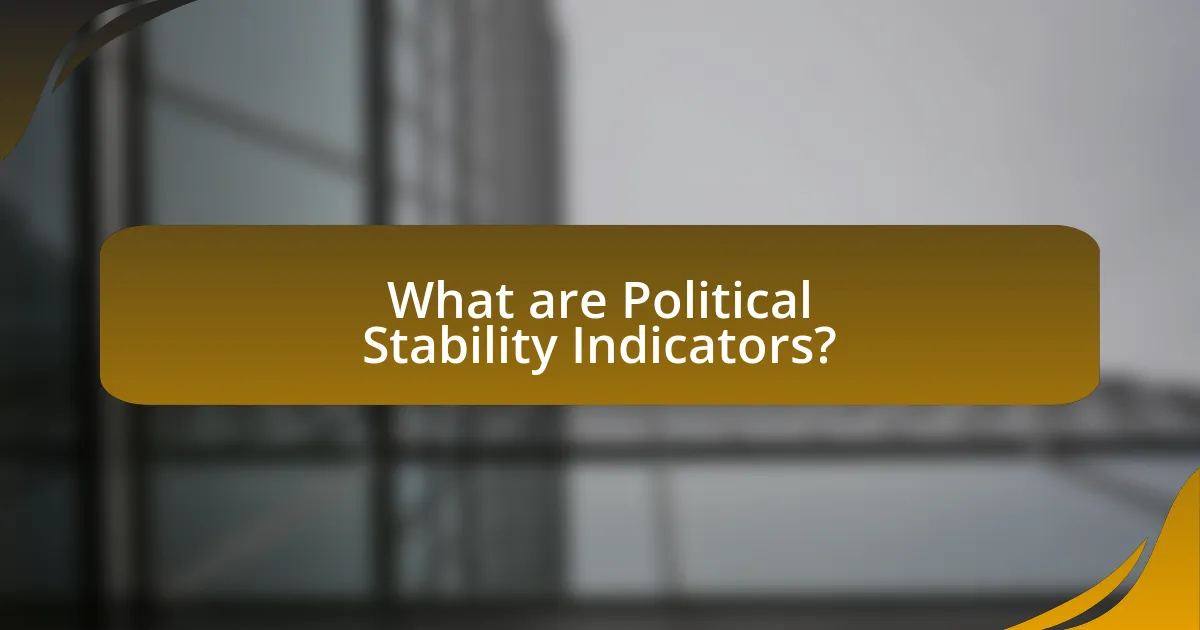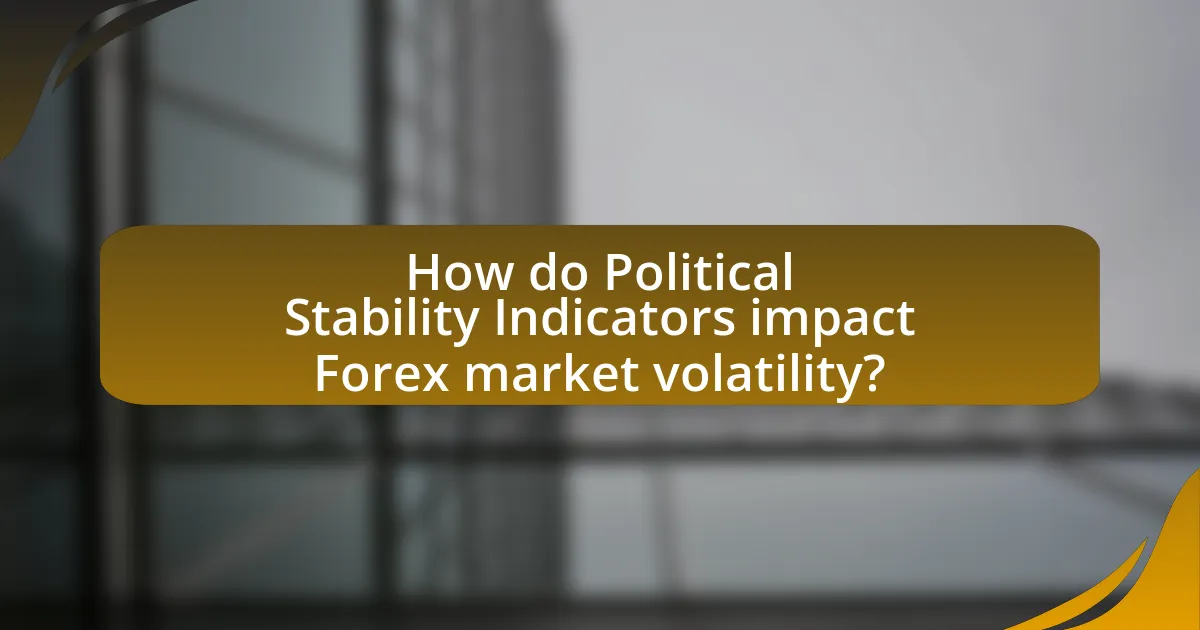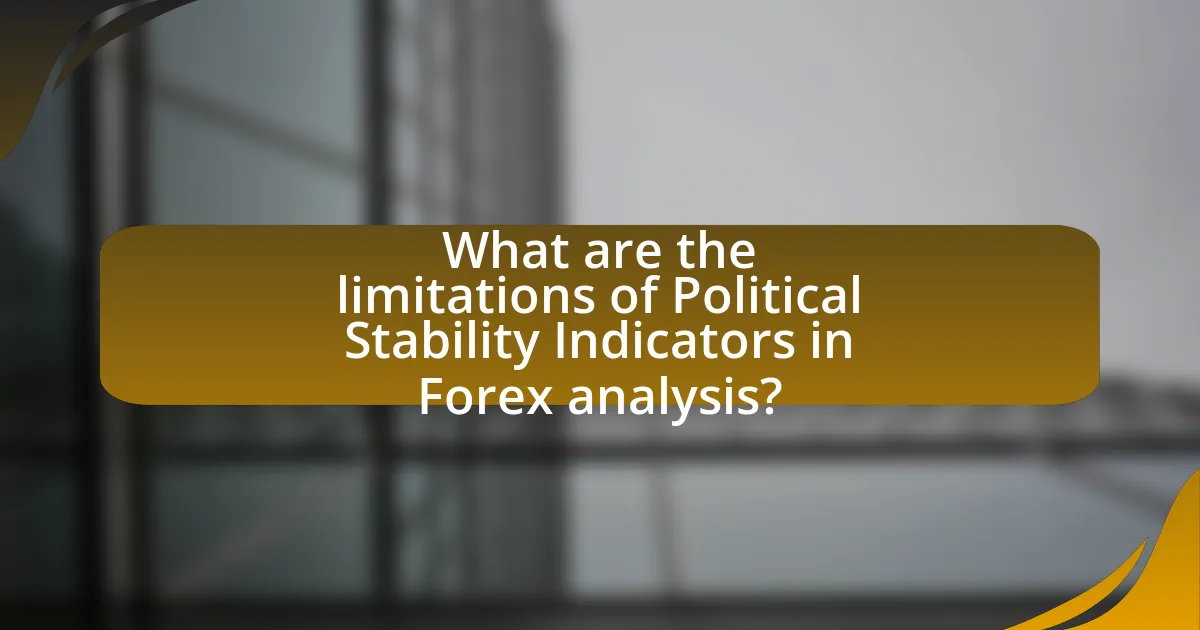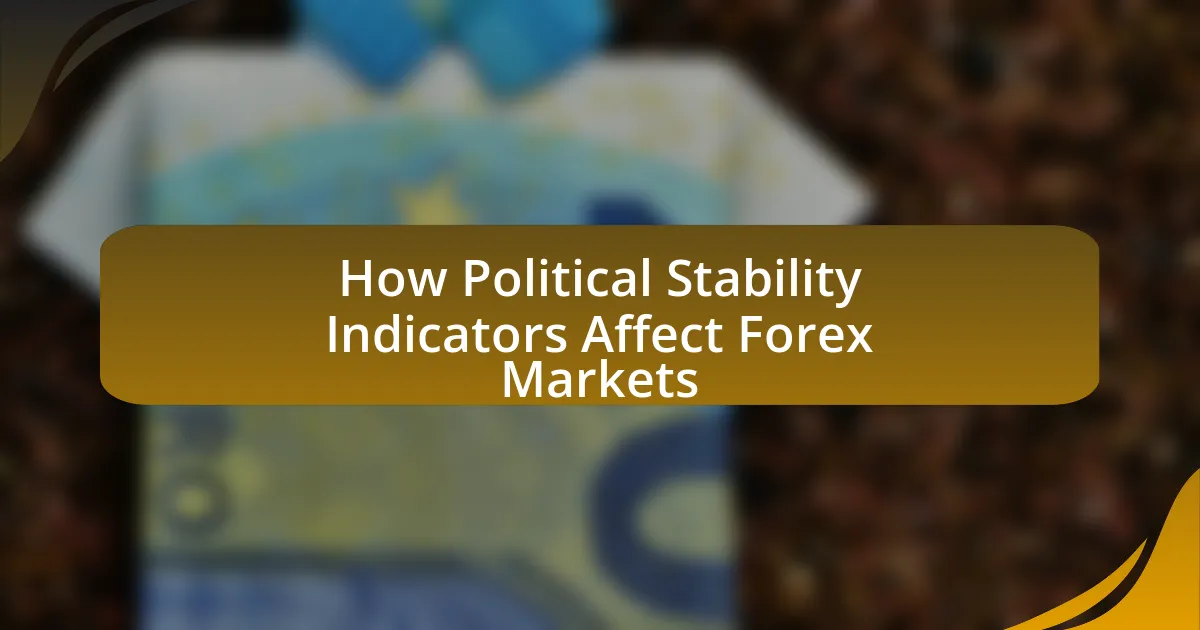Political stability indicators are essential metrics that evaluate the likelihood of unrest or instability within a country, encompassing factors such as government effectiveness, political violence, social unrest, and the rule of law. These indicators significantly influence economic environments by affecting investor confidence and currency valuation, with stable political conditions attracting foreign investment and fostering economic growth. The article explores how political stability indicators interact with Forex markets, impacting currency valuation and volatility, and discusses the strategies traders employ to navigate risks associated with these indicators. Additionally, it highlights the limitations and challenges analysts face when interpreting these indicators, emphasizing the importance of a multifaceted approach in Forex trading.

What are Political Stability Indicators?
Political stability indicators are metrics that assess the likelihood of political unrest or instability within a country. These indicators include factors such as government effectiveness, political violence, social unrest, and the rule of law. For instance, the World Bank and the International Monetary Fund utilize various indices, such as the Worldwide Governance Indicators, to evaluate these aspects quantitatively. These metrics are crucial for investors and analysts as they provide insights into the risk environment, influencing decisions in forex markets where currency values can be significantly affected by political events and stability.
How do Political Stability Indicators influence economic environments?
Political stability indicators significantly influence economic environments by affecting investor confidence and economic growth. When a country exhibits high political stability, it typically attracts foreign direct investment, as investors perceive lower risks associated with political turmoil. For instance, according to the World Bank, countries with stable political environments often experience GDP growth rates that are 1-2% higher than those with political instability. Conversely, nations facing political unrest may see capital flight and reduced economic activity, as evidenced by the economic downturns in countries like Venezuela and Zimbabwe during periods of instability. Thus, political stability indicators serve as critical determinants of economic performance and investment attractiveness.
What specific factors are included in Political Stability Indicators?
Political Stability Indicators include factors such as government effectiveness, political violence, social unrest, and the rule of law. These indicators assess the likelihood of political instability and its potential impact on economic conditions. For instance, a study by the World Bank highlights that countries with higher government effectiveness and lower levels of political violence tend to experience more stable economic environments, which directly influences foreign exchange markets.
How do these factors interact with each other?
Political stability indicators interact with forex markets by influencing investor confidence and currency valuation. When political stability is high, investors are more likely to invest in a country’s assets, leading to an appreciation of its currency. Conversely, political instability can result in capital flight, causing a depreciation of the currency. For example, during periods of political unrest, such as the Arab Spring, many currencies in affected regions experienced significant declines due to uncertainty and risk aversion among investors. This relationship demonstrates that political stability directly impacts forex market dynamics through changes in investor behavior and market sentiment.
Why are Political Stability Indicators important for Forex markets?
Political Stability Indicators are crucial for Forex markets because they directly influence investor confidence and currency valuation. When a country demonstrates high political stability, it typically attracts foreign investment, leading to increased demand for its currency. For instance, according to the World Bank, nations with stable political environments often experience lower volatility in their exchange rates, making them more appealing to traders. Conversely, political instability can lead to rapid currency depreciation, as seen in countries like Venezuela, where political turmoil has resulted in hyperinflation and a collapse of the national currency. Thus, the assessment of political stability is essential for predicting currency movements and making informed trading decisions in the Forex market.
What role do these indicators play in investor decision-making?
Political stability indicators significantly influence investor decision-making by providing insights into the risk and potential returns associated with investments in a particular country. Investors analyze these indicators, such as government stability, social unrest, and economic performance, to assess the likelihood of favorable or unfavorable market conditions. For instance, a study by the International Monetary Fund found that countries with higher political stability attract more foreign direct investment, as investors seek to minimize risk. Thus, these indicators serve as critical tools for investors to gauge the overall investment climate and make informed decisions.
How do Political Stability Indicators affect currency valuation?
Political stability indicators significantly influence currency valuation by affecting investor confidence and economic performance. When a country demonstrates high political stability, it typically attracts foreign investment, leading to increased demand for its currency. For instance, according to the World Bank, countries with stable political environments often experience lower risk premiums, which can strengthen their currencies. Conversely, political instability, such as civil unrest or government corruption, can lead to capital flight and depreciation of the currency, as seen in Venezuela’s economic crisis, where political turmoil resulted in hyperinflation and a plummeting currency value. Thus, political stability directly correlates with currency strength through its impact on investment flows and economic stability.

How do Political Stability Indicators impact Forex market volatility?
Political stability indicators significantly impact Forex market volatility by influencing investor confidence and currency demand. When a country exhibits high political stability, it typically attracts foreign investment, leading to a stronger currency and reduced volatility. Conversely, low political stability often results in uncertainty, prompting investors to withdraw their capital, which can cause sharp fluctuations in currency values. For instance, during the Arab Spring in 2011, countries like Egypt experienced heightened political instability, leading to a dramatic depreciation of the Egyptian pound against major currencies, illustrating the direct correlation between political stability and Forex volatility.
What is the relationship between political stability and Forex market fluctuations?
Political stability significantly influences Forex market fluctuations, as stable political environments tend to attract foreign investment and strengthen a country’s currency. For instance, countries with low political risk, such as Switzerland, often experience stronger currencies due to investor confidence. Conversely, political instability, such as that seen during the Arab Spring, can lead to rapid currency depreciation as investors withdraw their capital, fearing economic downturns. Historical data shows that during periods of political unrest, like the 2016 Brexit referendum, the British pound experienced substantial volatility, dropping sharply against major currencies. This correlation between political stability and Forex fluctuations underscores the importance of political conditions in shaping market dynamics.
How can sudden changes in political stability affect currency pairs?
Sudden changes in political stability can significantly impact currency pairs by causing volatility and altering investor sentiment. For instance, when a country experiences political unrest or a sudden change in government, it often leads to uncertainty regarding economic policies, which can result in a depreciation of that country’s currency. Historical examples include the Arab Spring in 2011, where currencies in affected regions, such as the Egyptian pound, faced sharp declines due to instability. Additionally, currency pairs involving stable currencies, like the US dollar or Swiss franc, may appreciate as investors seek safe-haven assets during times of political turmoil. This relationship illustrates how political stability directly influences currency valuation and trading behavior in the forex market.
What historical examples illustrate this relationship?
Political stability indicators significantly affect forex markets, as illustrated by the 2016 Brexit referendum. Following the announcement of the referendum, the British pound experienced a sharp decline, losing approximately 10% of its value against the US dollar within days. This decline was driven by uncertainty regarding the UK’s political and economic future, demonstrating how political instability can lead to currency depreciation. Another example is the 2011 Arab Spring, where political upheaval in countries like Egypt led to a significant drop in the Egyptian pound, reflecting the direct impact of political instability on forex values. These instances underscore the correlation between political stability and currency strength in the forex market.
How do traders utilize Political Stability Indicators in Forex trading?
Traders utilize Political Stability Indicators in Forex trading to assess the risk associated with currency investments in politically unstable regions. By analyzing indicators such as government stability, social unrest, and the likelihood of conflict, traders can make informed decisions about entering or exiting positions in specific currencies. For example, a country experiencing political turmoil may see its currency depreciate due to decreased investor confidence, prompting traders to sell that currency or avoid it altogether. Historical data shows that currencies from politically stable countries, like Switzerland, tend to perform better during global uncertainties, reinforcing the importance of these indicators in trading strategies.
What strategies do traders employ based on these indicators?
Traders employ strategies such as trend following, mean reversion, and breakout trading based on political stability indicators. Trend following involves analyzing indicators to identify and capitalize on prevailing market trends influenced by political events, such as elections or policy changes. Mean reversion strategies rely on the assumption that currency prices will revert to their historical averages after significant political shifts, prompting traders to buy undervalued currencies or sell overvalued ones. Breakout trading focuses on entering positions when currency prices move beyond established support or resistance levels, often triggered by political announcements that signal changes in stability. These strategies are validated by historical data showing that political events significantly impact currency volatility and price movements, making them essential for informed trading decisions.
How can traders assess the reliability of Political Stability Indicators?
Traders can assess the reliability of Political Stability Indicators by analyzing the methodology used to compile these indicators, including the data sources, frequency of updates, and the credibility of the organizations producing them. For instance, indicators from reputable institutions like the World Bank or the International Monetary Fund are generally considered more reliable due to their rigorous data collection and analysis processes. Additionally, traders should compare multiple indicators to identify trends and discrepancies, as consistency across various sources can enhance reliability. Historical performance data, such as how past political stability indicators correlated with market movements, can also provide insights into their predictive power and reliability.

What are the limitations of Political Stability Indicators in Forex analysis?
Political Stability Indicators have several limitations in Forex analysis, primarily due to their inability to capture real-time changes and the complexity of political environments. These indicators often rely on historical data, which may not accurately reflect current political dynamics or sudden shifts in governance, such as coups or protests. Additionally, the subjective nature of some indicators can lead to inconsistencies in measurement, as different organizations may use varying methodologies to assess political stability. For instance, the World Bank and the International Monetary Fund may produce differing assessments based on their criteria, leading to confusion among Forex traders. Furthermore, these indicators may not account for external factors, such as global economic conditions or geopolitical tensions, which can significantly influence currency values. Thus, while Political Stability Indicators provide valuable insights, their limitations necessitate a cautious approach when used in Forex analysis.
What challenges do analysts face when interpreting these indicators?
Analysts face several challenges when interpreting political stability indicators, primarily due to the complexity and subjectivity of these metrics. Political stability indicators often rely on qualitative assessments, which can vary significantly based on the analyst’s perspective or bias, leading to inconsistent interpretations. Additionally, the dynamic nature of political environments means that indicators can quickly become outdated or misrepresent the current situation, as seen in countries experiencing rapid political change, such as during the Arab Spring. Furthermore, the interdependence of various indicators complicates analysis; for instance, economic performance, social unrest, and governance quality can all influence political stability, making it difficult to isolate the impact of a single indicator on forex markets. These challenges highlight the necessity for analysts to employ a multifaceted approach, integrating quantitative data with qualitative insights to enhance the accuracy of their interpretations.
How can misinterpretation of Political Stability Indicators lead to trading errors?
Misinterpretation of Political Stability Indicators can lead to trading errors by causing traders to make decisions based on inaccurate assessments of a country’s risk profile. For instance, if a trader misreads a decline in political stability as a minor issue rather than a significant threat, they may underestimate the potential for currency depreciation. Historical data shows that during the Arab Spring, many traders failed to recognize the implications of political unrest, leading to substantial losses as currencies in affected regions plummeted. This demonstrates that accurate interpretation of political stability is crucial for informed trading decisions, as misjudgments can result in financial losses and missed opportunities.
What external factors can influence the effectiveness of these indicators?
External factors that can influence the effectiveness of political stability indicators include economic conditions, geopolitical events, and social unrest. Economic conditions, such as inflation rates and unemployment levels, can affect investor confidence and thus the perceived stability of a country. For instance, high inflation may lead to currency depreciation, impacting forex markets. Geopolitical events, like conflicts or diplomatic relations, can also alter perceptions of stability; for example, tensions in the Middle East often lead to volatility in oil prices, which in turn affects currencies of oil-dependent economies. Additionally, social unrest, such as protests or strikes, can signal instability, prompting investors to withdraw from affected markets, thereby influencing forex rates. These factors collectively shape the context in which political stability indicators are interpreted and their subsequent impact on forex markets.
How can traders mitigate risks associated with Political Stability Indicators?
Traders can mitigate risks associated with Political Stability Indicators by diversifying their investment portfolios and employing risk management strategies such as stop-loss orders. Diversification reduces exposure to any single political event by spreading investments across various assets and regions, thereby minimizing potential losses from political instability in one area. For instance, during the Arab Spring, traders who had diversified portfolios were less affected by the volatility in the Middle East compared to those heavily invested in that region. Additionally, using stop-loss orders allows traders to automatically sell assets when they reach a certain price, limiting losses during sudden political upheavals. Historical data shows that traders who implemented these strategies during periods of political unrest, such as the Brexit referendum, were able to protect their investments more effectively than those who did not.
What best practices should traders follow when considering these indicators?
Traders should prioritize the analysis of political stability indicators by integrating them into their overall trading strategy. This involves closely monitoring key indicators such as government stability, policy continuity, and geopolitical risks, as these factors can significantly influence currency values. For instance, a study by the International Monetary Fund found that countries with higher political stability tend to experience stronger currency performance, highlighting the importance of these indicators in forecasting market movements. Additionally, traders should utilize a combination of technical analysis and fundamental analysis to validate their trading decisions, ensuring that they are not solely reliant on political indicators but also considering market sentiment and economic data.
How can diversification strategies help in managing risks?
Diversification strategies help in managing risks by spreading investments across various assets, thereby reducing exposure to any single asset’s volatility. This approach mitigates the impact of adverse events affecting specific sectors or markets, as losses in one area can be offset by gains in another. For instance, during periods of political instability, certain currencies may depreciate, but a diversified portfolio that includes stable assets or currencies can maintain overall value. Historical data shows that diversified portfolios tend to have lower volatility and higher risk-adjusted returns compared to concentrated investments, reinforcing the effectiveness of diversification in risk management.
